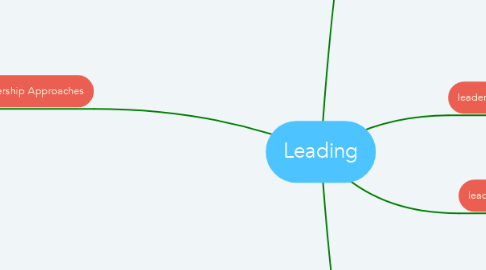
1. Leadership Approaches
1.1. The trait approach
1.1.1. sees the personal characteristic of an individual as the main determinants of how successful that individual could be as a leader
1.2. Behavioral theories: The Ohio State University Studies
1.2.1. researches studied the behaviors of leaders and found two critical behaviors called:
1.2.1.1. initiating structure leadership behavior
1.2.1.2. consideration leadership behavior
1.3. Behavioral theories: The Michigan University Studies
1.3.1. basic types of leader behaviors:
1.3.1.1. production-centered behavior
1.3.1.2. employee -centered behavior
1.4. Behavioral theories: The Managerial Grid
1.4.1. styles of leadership:
1.4.1.1. the indifferent, Style(1,1)
1.4.1.2. the accommodating, style(1,9)
1.4.1.3. dictatorial, style(9,1)
1.4.1.4. the status quo, style(5,5)
1.4.1.5. the sound, style(9,9)
1.5. Contingency theories: Hersey Blanchard Life Cycle Theory
1.5.1. describes how leaders should adjust their leadership style in response to their subordinates' situation that evolving desire for achievement, experience, ability and willingness to accept responsibility
1.5.2. phases of leadership:
1.5.2.1. 1st phase(telling/directing)
1.5.2.2. 2nd phase(selling/coaching)
1.5.2.3. 3rd phase(participating/supporting)
1.5.2.4. 4th phase(delegating)
1.6. Contingency theories: The Path Goal Theory
1.6.1. emphasizing on the leader's role in clarifying for subordinates how they can achieve high performance and its associated rewards
1.6.2. types of behavior:
1.6.2.1. directive
1.6.2.2. supportive
1.6.2.3. participative
1.6.2.4. achievement
2. leader?
2.1. persons who can influence the behavior of others without having to rely on force or those accepted by others
3. leading?
3.1. motivating and directing the members of the organization so that they contribute to the achievement of the goals of the organization
4. leadership?
4.1. process of directing the behavior of others toward the accomplishment of some objectives or causing individuals to act in a certain way or to follow a particular course
4.2. involves:
4.2.1. creating a vision of the future
4.2.2. devising strategy for achieve the vision
4.2.3. communicating the vision so that everyone understands and believes in it
4.3. importance:
4.3.1. make contributions to organization
4.3.2. enhance and obtain cooperation
4.3.3. encourage teamwork
4.3.4. motivate employees to generate good work
5. power
5.1. ability to marshal human, information or material resources to get something done
5.2. individual's capacity to influence decisions
5.3. types(sources):
5.3.1. position
5.3.2. personal
